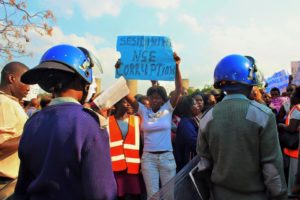Minds of the Movement
An ICNC blog on the people and power of civil resistance
by Shaazka BeyerleDecember 09, 2019
2019 is being called the year of protest. Citizens across the globe are galvanizing, in large part over the nexus of corruption, inequality, and a sense that governments and political elites are unaccountable and unresponsive to their needs. “People are saying ‘pay attention to us, you are there to serve us,’” observed Nancy Lindborg, President of the United States Institute of Peace. This wave of people power shows that governments—whether they are democratic, semi-democratic, or authoritarian—are not immune to collective civic pressure.

Today's anti-corruption campaigns have roots in the recent past. Here, a woman holds a placard saying "We are tired of corruption" at a Women of Zimbabwe Arise (WOZA) protest in 2016. Source: Zimbabwe Today's Facebook page.
We have witnessed the enormous achievements of the nonviolent Revolution of Smiles in Algeria and the Movement for Freedom and Change in Sudan, which unseated long-time brutal dictators, the latter involved in armed conflict. It’s no small feat to pressure prime ministers to resign, most recently in Lebanon and Iraq, two countries riddled with sectarian divisions. Other leaders are backtracking on price hikes and making concessions, including in Chile and Colombia. Protests are rattling authoritarian and backsliding governments in Egypt, Georgia, Poland, Russia, Zimbabwe, and beyond. They follow on the heels of social movements in 2018, including Armenia’s Velvet Revolution and Renuncia Ja (Resign Now) in Puerto Rico, organized campaigns for transparency, accountability, and good governance (TAGG) in Kenya, Nigeria, South Africa, and Ukraine, and large-scale demonstrations from Haiti to Guatemala, Israel, Jordan, Mongolia, Peru, and Romania.
But these outcomes have also come with grim costs. Some demonstrations have disintegrated into riots, marred by civilian looting, property destruction, and violence. Many hundreds of lives have been lost, particularly in Iraq and Iran, where security forces have used live ammunition to suppress dissent. Ongoing nonviolent struggles in Nicaragua and Venezuela have been facing lethal repression.
Even when a corrupt leader or powerful figure is out of the picture, protesters understand that the rotten system remains. They also know from lived experience that corruption is linked to the wider problems they face—including unaccountable elites, poor public services, dismal educational and economic opportunities, scanty justice and human security, and violent conflict. Their struggles don’t fit the silos created by international actors. “Since I was my daughter's age there have been the same rulers they are robbing the country—they are taking our rights,” said Lina, a Lebanese protester. “They give us promises and lies and we are still at the same place.”
Six Takeaways for a New Decade of People Power
What comes next? How can people power be harnessed for the long haul? How can we move from the year of protest to a new decade of transformation? What can we learn from research, the practice of strategic nonviolent action, and social movements and organized civic initiatives targeting corruption on the ground? To start the conversation, here are six takeaways.
1. Systemic approach. Corruption functions in systems, making it virtually impossible to identify, punish, or reform all corruptors or stop all malfeasant transactions. To impact it, we need to redefine corruption as a system of abuse of entrusted power for private, collective, or political gain, often involving a complex, intertwined set of relationships, some obvious, others hidden, with established vested interests, that can operate vertically within an institution or horizontally cut across political, economic, and social spheres in a society or transnationally.
2. Nonviolent action strategies. To impact and ultimately transform systems of graft and abuse, my research has found that citizen-driven initiatives have used the following strategies:
- Shifting power—applying nonviolent pressure through “power of numbers”; people raising their collective voice over specific demands on elites who (up to that point) have been unwilling to change the venal status quo.
- Disruption—hampering the smooth functioning of systems of graft and abuse.
- Positive engagement and reinforcement vis-à-vis powerholders—“pulling” them toward the civic initiative and anti-corruption/accountability struggle; and empowering those on the “inside”—honest elites, reformers, and integrity-championing institutions—through grassroots solidarity and social recognition (such as Accountability Lab’s Integrity Icon campaigns), that in turn contribute to shifting norms.
- Connecting citizens’ grievances and problems to anti-corruption objectives and demands.
- Incremental objectives and outcomes—mapping a path for transformative change based on clear objectives and specific demands that build on one another, yield visible outcomes, and foster a sense of citizen agency, inclusion, and dignity. In fragile and closed contexts, this often takes the form of locally led community initiatives, which can inspire others and feed into national efforts for major policy/legislative reforms and implementation. Jonathan Fox and Joy Aceron documented this process, naming it Vertical Integration.
3. Three principles for success. ICNC’s Peter Ackerman and Hardy Merriman have identified three core principles for success that are essential for sustained, effective social movements and campaigns: unity of people, groups, grievances, and objectives; strategic planning, organization, leadership, and context analysis; and nonviolent discipline, defined by Merriman as “the ability of people to remain nonviolent, even in the face of provocations.” Breakdowns in nonviolent discipline can result in violent clashes with security forces, give oppressors an excuse to crackdown, delegitimize civic initiatives, and dissolve broad-based citizen participation, thereby sapping a movement or campaign’s main source of power. For Louisa Ammi, an Algerian photojournalist who documented the Revolution of Smiles, “Algerians understood that the violence leads nowhere. The people at the top didn’t believe we could protest peacefully.”
4. Repression and backfire. Vested interests benefitting from corruption are not happy when their private or collective gains are threatened by investigative journalists, movements, civil society organizations, and even elite integrity champions and institutions. They’ll counter with obstacles, intimidation, and violence. Brian Martin, a leading expert on whistleblowing and repression, has developed the Backfire Model, a practical framework for activists to understand the tactics used by “perpetrators of injustice” and, importantly, nonviolent tactics to counter them.
5. Beyond protest. Social movements, campaigns, and community-based civic initiatives cannot survive solely on protests. In many contexts, demonstrations are hard to control, face repression, and run the risk of infiltration by violent groups and agents provocateurs planted by oppressors. There are literally hundreds of nonviolent tactics to contextualize, and groups create new ones all the time. In the anti-corruption realm this includes: blacklisting “unfit” politicians during elections; and citizen-led or community-driven monitoring of budgets, spending, infrastructure, schools, clinics, courtrooms, and parliaments. In closed civic spaces, rather than put people in harm’s way, movements have devised many low-risk mass actions. Synchronized banging on pots and pans, switching off lights, and honking horns are common, as are the use of humor, art, culture, and digital resistance. And then there are wildly creative tactics, such as calling the population to a stay-away by writing on thousands of banknotes.
6. Efficacy of nonviolent action. The overwhelming evidence is that nonviolent action is vastly superior to violent struggle. Taken together, research by my colleagues, Maria Stephan and Jonathan Pinckney, and Erica Chenoweth and Evan Perkoski, have found that: nonviolent campaigns are twice as effective as violent campaigns; take about one-third as long as violent campaigns to end; are nine times more likely to lead to a democracy after five years; contribute to a higher level of democracy, are 45 percent less likely to elicit mass killing; and are six times more successful amid regime repression.
Today, on International Anti-Corruption Day, let’s reframe the discourse, too often saddled by negatives, by adding the positives of hope, collective empowerment, incremental victories, integrity, and affinity for one’s community and country. From Beirut comes the slogan, “Lebanon in peace not pieces.”
The views expressed are the author's own and do not represent any entity to which she is affiliated.

Shaazka Beyerle
Shaazka Beyerle is a senior fellow with the Terrorism, Transnational Crime, and Corruption Center, George Mason University. She’s a researcher, writer, and educator in nonviolent action, focusing on anti-corruption, peacebuilding, gender, and human rights, and author of Supporting Nonviolent Action and Movements: A Guide for International Actors (United States Institute of Peace).
Read More